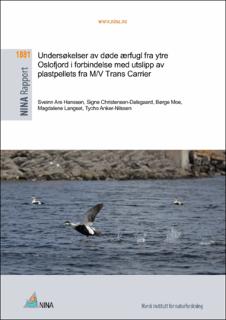Undersøkelser av døde ærfugl fra ytre Oslofjord i forbindelse med utslipp av plastpellets fra M/V Trans Carrier
Hanssen, Sveinn Are; Christensen-Dalsgaard, Signe; Moe, Børge; Langset, Magdalene; Anker-Nilssen, Tycho
Research report

Åpne
Permanent lenke
https://hdl.handle.net/11250/2681831Utgivelsesdato
2020Metadata
Vis full innførselSamlinger
- NINA Rapport/NINA Report [2341]
Sammendrag
Hanssen, S.A., Christensen-Dalsgaard, S., Moe, B. Langset, M. & Anker-Nilssen, T. 2020. Undersøkelser av døde ærfugl fra ytre Oslofjord i forbindelse med utslipp av plastpellets fra M/V Trans Carrier. NINA Rapport 1881. Norsk institutt for naturforskning.
23 februar 2020 ble en container på frakteskipet M/V Trans Carrier skadet i uvær og anslagsvis 13,2 tonn plastpellets lekket ut i havet vest for Danmark. I løpet av de neste ukene ble en stor del av disse fraktet med vind og havstrømmer til den norske delen av Skagerrakkysten. Denne hendelsen sammenfalt med at det i mars 2020 ble funnet mange døde og døende ærfugler i ytre Oslofjord. Til sammen 104 døde ærfugler ble tatt vare på av lokalt personale fra Statens Natur-oppsyn (SNO) og sendt til NINA i Trondheim for nærmere analyse og obduksjon. Målet med disse undersøkelsene har vært å avdekke fuglenes kondisjon og eventuelle fysiologiske avvik som kan bidra til å forklare denne massedødshendelsen. Foreløpige analyser viser at de døde ærfuglene var sterkt avmagret og sannsynligvis hadde omkommet av sult. Plastpellets kan, hvis de blir spist, fylle opp mage- og tarmsystemet og dermed hindre fordøyelsen av naturlige føde-emner. Vi undersøkte derfor fordøyelsessystemet på et utvalg av de obduserte fuglene mer nøye. Femti fugler ble tilfeldig valgt ut; 25 fra vestsiden av ytre Oslofjord til Agder og 25 fra østsiden av ytre Oslofjord.
Det ble funnet plastpellets i 2 (4 %) av de undersøkte fuglene og da kun i små mengder. Det er derfor vår vurdering at inntak av plastpellets hos ærfugl har skjedd i liten grad og at det ikke kan forklare den økte vinterdødeligheten hos ærfugl i ytre Oslofjord våren 2020. Hanssen, S.A., Christensen-Dalsgaard, S., Moe, B., Langset, M. & Anker-Nilssen, T. 2020. Investigations of dead eider ducks from outer Oslo fiord in connection with the leakage of plastic pellets M/V Trans Carrier. NINA Report 1881. Norwegian Institute for Nature Research.
On 23 February 2020, a container on the cargo ship M/V Trans Carrier was damaged in a storm and an estimated 13.2 tonnes of industrial plastic pellets leaked into the sea west of Denmark. During the next few weeks a large part of the pellets were transported by wind and ocean currents to the Norwegian part of the Skagerrak coast. This incident coincided with the fact that in March 2020, many dead and dying eider ducks were found in the outer Oslofjord area. Altogether 104 dead common eiders Somateria mollissima were collected by local staff from the Norwegian Nature Surveillance (SNO) and shipped to NINA in Trondheim for further analysis and autopsy. The aim of these investigations has been to uncover the birds’ body condition and any physio-logical abnormalities that can help explain the causes for this wreck incident. Preliminary anal-yses show that the dead eiders were severely emaciated, indicating they most likely had died from starvation. Plastic pellets can, if eaten, fill the stomach and intestinal system and thereby prevent the digestion of natural food items. We therefore examined the gastrointestinal system on a selection of the autopsied birds more carefully. Fifty birds were randomly selected; 25 from the west side of the outer Oslofjord and 25 from the east side of the outer Oslofjord.
Plastic pellets were found in only 2 (4%) of the examined birds and then only in small quantities. We therefore conclude that the intake of plastic pellets by eiders only occurred to a small extent and cannot explain the increased winter mortality of eiders in the outer Oslofjord in spring 2020.